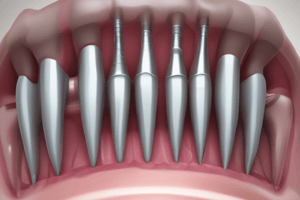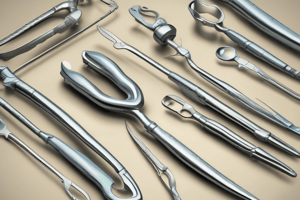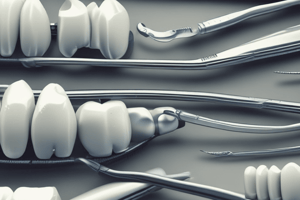Podcast
Questions and Answers
What is the purpose of rounding the axio-pulpal line angle in dental procedures?
What is the purpose of rounding the axio-pulpal line angle in dental procedures?
- To increase tooth sensitivity
- To avoid stress concentration (correct)
- To enhance aesthetic appearance
- To reduce the risk of microleakage
Which grasp is most appropriate for delicate work and finishing enamel walls?
Which grasp is most appropriate for delicate work and finishing enamel walls?
- Power grip
- Modified palm and thumb grasp
- Pen grasp (correct)
- Palm and thumb grasp
What is one significant advantage of using hand cutting instruments over rotary cutting instruments?
What is one significant advantage of using hand cutting instruments over rotary cutting instruments?
- They require less skill to operate
- They do not cut into sound tooth structure (correct)
- They are faster in operation
- They are less expensive
What is a characteristic of rotary cutting instruments?
What is a characteristic of rotary cutting instruments?
When should the palm and thumb grasp be utilized in dental procedures?
When should the palm and thumb grasp be utilized in dental procedures?
What does the first number in Black's formula represent?
What does the first number in Black's formula represent?
Which material of instruments offers better cutting efficiency?
Which material of instruments offers better cutting efficiency?
How are instruments classified according to beveling?
How are instruments classified according to beveling?
What function do excavators serve?
What function do excavators serve?
In Black's formula, when is the fourth number added?
In Black's formula, when is the fourth number added?
Which classification pertains to instruments based on the number of ends?
Which classification pertains to instruments based on the number of ends?
What is the advantage of stainless steel instruments?
What is the advantage of stainless steel instruments?
What is meant by 'contra-angling' in hand instruments?
What is meant by 'contra-angling' in hand instruments?
What effect does increasing the number of blades on a bur have?
What effect does increasing the number of blades on a bur have?
Which type of bur has the highest cutting efficiency?
Which type of bur has the highest cutting efficiency?
What is the best rake angle for cutting efficiency?
What is the best rake angle for cutting efficiency?
How does an increase in pressure affect the bur's performance?
How does an increase in pressure affect the bur's performance?
Which tissue is harder and therefore affects cutting efficiency of the bur?
Which tissue is harder and therefore affects cutting efficiency of the bur?
Why are inverted cone burs more efficient compared to fissure burs?
Why are inverted cone burs more efficient compared to fissure burs?
What is the relationship between bur speed and cutting efficiency?
What is the relationship between bur speed and cutting efficiency?
Which coolant type is considered the best for dental cutting?
Which coolant type is considered the best for dental cutting?
What happens if a positive rake angle is utilized excessively?
What happens if a positive rake angle is utilized excessively?
What is one of the primary functions of coolant during dental procedures?
What is one of the primary functions of coolant during dental procedures?
Which statement accurately differentiates dental stones from dental burs?
Which statement accurately differentiates dental stones from dental burs?
What is a primary consequence of using abrasive instruments on dentin?
What is a primary consequence of using abrasive instruments on dentin?
What is a characteristic of carbide burs compared to abrasives?
What is a characteristic of carbide burs compared to abrasives?
What is the maximum lateral displacement of the working point of an instrument as defined for run-out?
What is the maximum lateral displacement of the working point of an instrument as defined for run-out?
What should always be used along with dental abrasives during procedures?
What should always be used along with dental abrasives during procedures?
Which of the following is NOT a cause of run-out?
Which of the following is NOT a cause of run-out?
How does increased pressure affect friction during the cutting process?
How does increased pressure affect friction during the cutting process?
Which is NOT a function of coolant mentioned in the content?
Which is NOT a function of coolant mentioned in the content?
Which effect does excessive heat generation have on dental pulp?
Which effect does excessive heat generation have on dental pulp?
Which statement correctly describes the use of amalgam carriers?
Which statement correctly describes the use of amalgam carriers?
What is a recommended method to control heat generation during dental procedures?
What is a recommended method to control heat generation during dental procedures?
What is the potential consequence of pulp temperature exceeding 135°F?
What is the potential consequence of pulp temperature exceeding 135°F?
Which factor does NOT affect the amount of friction during dental cutting procedures?
Which factor does NOT affect the amount of friction during dental cutting procedures?
What is an effective way to decrease friction in dental tools?
What is an effective way to decrease friction in dental tools?
What are the main advantages of air abrasion in cavity preparation?
What are the main advantages of air abrasion in cavity preparation?
Which of the following is a disadvantage of laser treatment in cavity preparation?
Which of the following is a disadvantage of laser treatment in cavity preparation?
What is a key characteristic of sonic instruments in dentistry?
What is a key characteristic of sonic instruments in dentistry?
What is the primary purpose of Carisolv gel in dentistry?
What is the primary purpose of Carisolv gel in dentistry?
Which of the following represents a common misconception about rotary cutting instruments?
Which of the following represents a common misconception about rotary cutting instruments?
What component of hand cutting instruments connects the shaft to the blade?
What component of hand cutting instruments connects the shaft to the blade?
Enzymes like Pronase are used in cavity preparation mainly to:
Enzymes like Pronase are used in cavity preparation mainly to:
Which part of a hand cutting instrument is primarily responsible for grasping during use?
Which part of a hand cutting instrument is primarily responsible for grasping during use?
Flashcards
Hand cutting instruments
Hand cutting instruments
Hand-held tools used to cut enamel and/or dentin and shape the prepared cavity.
Shaft or Handle (Hand cutting instrument)
Shaft or Handle (Hand cutting instrument)
The part of a hand cutting instrument you hold for grip, often with textured or angled surfaces to prevent slipping.
Shank (Hand cutting instrument)
Shank (Hand cutting instrument)
The connecting piece between the shaft and blade of a hand cutting instrument.
Blade (Hand cutting instrument)
Blade (Hand cutting instrument)
Signup and view all the flashcards
Air Abrasion
Air Abrasion
Signup and view all the flashcards
Laser (Waterlase)
Laser (Waterlase)
Signup and view all the flashcards
Sonic Instruments
Sonic Instruments
Signup and view all the flashcards
Chemo-mechanical methods (Carisolv)
Chemo-mechanical methods (Carisolv)
Signup and view all the flashcards
Black's Formula
Black's Formula
Signup and view all the flashcards
First Number in Black's Formula
First Number in Black's Formula
Signup and view all the flashcards
Second Number in Black's Formula
Second Number in Black's Formula
Signup and view all the flashcards
Third Number in Black's Formula
Third Number in Black's Formula
Signup and view all the flashcards
Fourth Number in Black's Formula
Fourth Number in Black's Formula
Signup and view all the flashcards
Stainless Steel
Stainless Steel
Signup and view all the flashcards
Carbon Steel
Carbon Steel
Signup and view all the flashcards
Direct Cutting
Direct Cutting
Signup and view all the flashcards
Rounded Axio-pulpal Line Angle
Rounded Axio-pulpal Line Angle
Signup and view all the flashcards
Reverse Bevel in Cast Gold
Reverse Bevel in Cast Gold
Signup and view all the flashcards
Pen Grasp
Pen Grasp
Signup and view all the flashcards
Palm and Thumb Grasp
Palm and Thumb Grasp
Signup and view all the flashcards
Rests in Instrument Use
Rests in Instrument Use
Signup and view all the flashcards
Cutting Efficiency
Cutting Efficiency
Signup and view all the flashcards
Tungsten Carbide Bur Material
Tungsten Carbide Bur Material
Signup and view all the flashcards
Number of Bur Blades
Number of Bur Blades
Signup and view all the flashcards
Rake Angle
Rake Angle
Signup and view all the flashcards
Tissue Hardness & Cutting Efficiency
Tissue Hardness & Cutting Efficiency
Signup and view all the flashcards
Bur Pressure & Cutting Efficiency
Bur Pressure & Cutting Efficiency
Signup and view all the flashcards
Bur Speed & Cutting Efficiency
Bur Speed & Cutting Efficiency
Signup and view all the flashcards
Inverted Cone vs. Fissure Bur
Inverted Cone vs. Fissure Bur
Signup and view all the flashcards
Eccentricity or Run-out
Eccentricity or Run-out
Signup and view all the flashcards
Run-Out Test
Run-Out Test
Signup and view all the flashcards
Heat Generation During Cutting
Heat Generation During Cutting
Signup and view all the flashcards
Factors Affecting Heat Generation
Factors Affecting Heat Generation
Signup and view all the flashcards
Heat Dissipation
Heat Dissipation
Signup and view all the flashcards
Effect of Heat on Pulp
Effect of Heat on Pulp
Signup and view all the flashcards
Control of Heat Generation
Control of Heat Generation
Signup and view all the flashcards
Coolant
Coolant
Signup and view all the flashcards
Coolant Functions
Coolant Functions
Signup and view all the flashcards
Dental Stones or Abrasives
Dental Stones or Abrasives
Signup and view all the flashcards
Abrasive Instruments: Enamel Cutting
Abrasive Instruments: Enamel Cutting
Signup and view all the flashcards
Carbide Burs: Dentin Cutting
Carbide Burs: Dentin Cutting
Signup and view all the flashcards
Amalgam Carrier
Amalgam Carrier
Signup and view all the flashcards
Biologically Compatible Coolants
Biologically Compatible Coolants
Signup and view all the flashcards
Body Temperature Maintenance
Body Temperature Maintenance
Signup and view all the flashcards
Sufficient Coolant
Sufficient Coolant
Signup and view all the flashcards
Study Notes
Instruments & Instrumentation - Operative Dentistry, Year 2
- General Classification of Operative Instruments: Instruments are categorized by their use, including isolation, exploration, tooth substance removal, restoration manipulation and finishing/polishing. Additional miscellaneous instruments complete the list.
Isolation of Operative Field
- Instruments maintain a dry operative field, including rubber dam placement, saliva ejectors, and high suction evacuation. Cotton roll holders also aid in this process.
Exploring the Operative Field
- Instruments used to assess the operative field, such as mouth mirrors and explorers (single-ended preferred). Magnifying loupes, microscopes, and intraoral cameras are also utilized.
Removing Tooth Substance
- Hand cutting instruments: Employed for precise cutting and shaping of tooth structure.
- Powered cutting instruments:
- Rotary cutting instruments: Burs and abrasive materials; used for creating cavities.
- Air abrasion: Air stream combined with abrasive particles (Aluminum oxide) for tooth removal.
- Laser (Waterlase): Absorbed by tooth and converted into heat, causing destruction and necrosis.
- Sonic instruments: Cutting ends with abrasive particles on one side and no abrasive on the other, to avoid injury to adjacent teeth. These are safe-sided tools.
Chemo-mechanical methods (Carisolv)
- Gel-based treatment: Applied to exposed carious dentin.
- Softens carious dentin which is removed after a set time using hand instruments, creating a caries-free cavity.
Enzymes
- Pronase: A non-specific enzyme that removes carious dentin.
Hand Cutting Instruments
- Definition: Tools used for cutting enamel and dentin for cavity preparation.
- Parts of H.C.I: Composed of a shaft/handle, shank, and blade.
- Shaft/Handle: Serrated or angulated for grip avoiding slippage.
- Shank: Straight or contra-angled; connects shaft to the blade.
- Blade: Performs cutting action and is specifically called 'NIB.'
- Manufacturer's Name, Designer, Kit Number, Black's Formula, and Indicating Marks (R or L) are engraved on instruments and aid in identification.
Black's Formula
- System of figures describing instrument measurements. Includes width of blade (first number), length of blade (second number), angle of blade to the shaft (third number), angle of cutting edge to the shaft (fourth number, if necessary). Fourth number appears in place of second number if needed.
Material of the Instruments
- P.O.C: Low Corrosion resistance, easily sharpened but also brittle.
- Carbon Steel: Excellent sharpness/cutting efficiency, but prone to corrosion.
- Stainless Steel: High corrosion resistance, but not as sharp or durable as carbon steel.
Types and Classification of Hand Cutting Instruments
- Classified by use (excavator, chisel), direction of cutting (direct, lateral), beveling (single, bi, triple, circumferential), and number of ends (single, double).
Excavators
- Definition: Used to remove soft carious dentin and shape cavity walls.
- Types: Straight, mono-angle, bin-angle, and triple-angled, spoon excavator.
- Functions: Excavate and remove carious dentin and shape the cavity walls. Carving of amalgam is possible using certain types.
Chisels
- Definition: Used to plan and cleave enamel and dentin, planning the walls of a cavity.
- Types: Straight, mono-angle, bin-angle, wedel and angel former (modified straight chisel).
Dental Cutting Burs
- Classification by material (e.g., tungsten carbide, steel) and by shape (e.g., rounded, inverted cone, fissure).
- Factors such as number of blades (cutting, finishing), length of shank, and blade angles (tooth, clearance, rake) affect efficiency.
Advantages of Hand over Rotary Instruments
- Conservative cutting (doesn't damage healthy tooth structure)
- No vibration or heat generation
- High efficiency and time saving
- Smoother, better finished surfaces
- Long life span.
Instrument Grasps, rests, and guards
- Grasps (methods of holding an instrument): Pen, palm-and-thumb, modified palm-and-thumb
- Rests: Fingers not holding on to support the instrument and avoid slippage.
- Guards: Fingers of the opposing hand used to protect adjacent tissues.
- Rotary cutting instruments: Burs used for cutting and abrasives for abrasion, along with specifics for electric and air operated hand pieces and shapes. The speed and type of motor influence use.
Cutting Efficiency
- Ability to remove maximum tooth structure with minimal effort and time.
- Factors that influence efficiency include bur material (hardness, high melting point, design), bur design, tissue type (enamel vs. dentin), pressure, and speed.
Eccentricity or Run-Out of Bur
- Maximum displacement, in mm, of bur from central axis; defects in the bur, its attachment, the hand piece, the junction between the motor and the hand piece cause eccentricity.
Heat Generation
- Friction between bur and tooth surface, generating unwanted heat. Pressure, speed, area of cutting, cutting efficiency, and time of cutting influence friction and thus heat generation.
- Dissipation of heat occurs through the tool, tooth, atmosphere, and formed dentin chips.
- Excessive heat can damage pulp tissue, leading to dehydration of pulp, burning lesions, pulp hyperemia, irreversible pulpal inflammation and thermal pulp shock.
Coolant
- Biologically compatible, similar body temperature, sufficient amount, directed to area to be cut. Types include water, air spray, and air/water spray. Function is to control heat, lubricate, improve vision, clean the bur, decrease pain, and prevent clogging, increasing its lifespan.
Dental Stones or Abrasives
- Differences from burs are that they use abrasive particles instead of cutting blades, intended for abrasion instead of cutting and the need for a plentiful supply of coolant because of increased friction and resultant heat generation.
- Abrasives are best used in extra-coronal situations, while carbide burs are most effective in intra-coronal situations.
Instruments Used for Manipulation and Packing Restorations
- Amalgam carrier: Instrument with hollow end for carrying amalgam increments.
- Condensers: Hand instruments used for packing and condensing amalgam.
- Plastic Instruments for Composite: Tools for handling, shaping, and manipulating composite materials.
- Triturating and Mixing instruments: Tools for amalgam mixing.
- Matrices: Used to shape and form cavities for restorations.
- Light curing units: To polymerize resinous composite materials.
Instruments for Shaping/Finishing/Polishing Restorations
- Burnishers: Instruments used to burnish amalgam and cast gold restorations. Available in various sizes.
- Carvers: Used to shape amalgam after packing and vary in shape for different aspects of the restoration.
- Plastic instruments for composite: Used for handling, shaping, and/or manipulating composite restorative materials.
- Hand finishing Instruments (e.g., orange wood sticks): Finishing strips used to finish composites.
- Rotary Finishing Instruments: Including brushes, rubber wheels, cups, points, and various finishing burs, abrasive finishing discs, and finishing stones.
Miscellaneous Instruments
- Instruments that do not fall into the above categories, such as mouth mirrors, probes, and pliers.
Studying That Suits You
Use AI to generate personalized quizzes and flashcards to suit your learning preferences.




